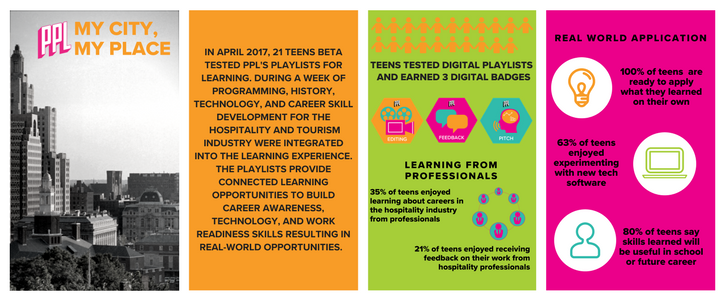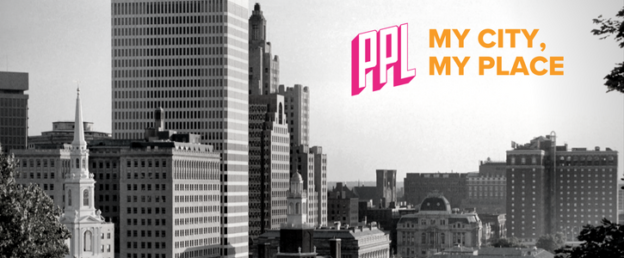Who were you addressing with your design objective?
While designing My City, My Place, we had a specific persona in mind. Our design persona was a public high school student who enjoys technology, isn’t that familiar with our library, and wants to showcase what makes their city/state “the place to be”.
What are the three essential questions the field needs to answer to move learning playlist design and implementation forward?
How realistic is it for youth to utilize playlists independently?
What is the incentive threshold for a youth to complete playlists?
What is the optimal environment, (formal, informal, self-guided, other) for playlists to thrive?
Have the goals for your project changed at all throughout the design process?
Ironically, the goals of our project changed and then changed back to the original plan. Initially, we wanted youth to have an XP that gave them the opportunity to do some self-discovery. We could not seem to make it fit in with the other material in the playlist and it was getting pretty lengthy. During our beta test, we left this section out. However, our team still felt the need for youth to explore their own identity. Alas, we created an additional playlist. We had a newly formed partnership with Leadership Rhode Island for another project and thought adding their expertise into this project was a natural fit for our new playlist.
What did you learn through the design process? What would you do differently if you were to start over?
Being newbies to the playlist world, we had a setback in the beginning: we let what we didn’t know about playlists allow us to second guess the expertise we had on our team. Our group consisted of well-versed educators from both informal and formal learning environments working together to design playlists. A few takeaways we learned from this experience were to trust your gut, play to your teammates’ strengths, start small and keep the project doable for your organization and the intended audience.
After getting over our initial hump, we discovered that it was easier for us to plan out the playlists in a programming format and then break it down into chunks that fit into the playlist style.
As we worked with partners to deliver expert content, we learned that playlists can mean different things to different people, even within the education sector. We found the need to educate our partners about playlists and their benefits in this context.
Although we were able to guesstimate the length of time an activity would take, it was difficult to predict. Thankfully, our beta test gave us a better idea of how long each XP would take. We would definitely recommend having a test group of youth go through pieces of the playlist before publishing the final product. The youth feedback and observations are vital to the design process.
What are the 3 most important things about designing your system or solution that you would share with another organization just getting started?
Throughout the design process, we tried to maintain youth voice. It was important for us to make sure that the playlists were written with youth in mind. Having a conversational tone and easy to understand directions helped show youth that we wanted them to have fun while learning.
We also realized quickly that it was not necessary to reinvent the wheel. By taking a look at past successful programs, we were able to create playlists following our own programming model. We would suggest that other organizations also do the same. If youth enjoyed a program before, figure out what the essence of that program was and how it could be converted into a playlist.
Additionally, we found that backward mapping worked well for our team. We started with the end product, a marketing pitch with a tourism focus, and then worked backward to build the steps needed to for a youth to be able to successfully create one.
What is left to do? What is left unanswered? What might help you continue to succeed?
We completed our beta testing and made edits to the playlists based on user feedback. There wasn’t much to edit because the youth enjoyed the process (please see infographic). We created a fourth playlist to act as an introduction to the project and to incorporate self-discovery.
 The remaining questions that we have are below.
The remaining questions that we have are below.
How long will we have access to the LRNG platform?
What has been the success of other organizations in continued use of playlists?
What are some best practices to garner buy-in from outside stakeholders like city officials and schools?
To ensure continued success, it would be helpful to be able to edit a playlist after it has been published. As user feedback comes in and partners change, an editing function becomes necessary.
What are the three essential questions the emerging field of connected learning playlist design needs to answer or make happen in order to move your work forward or scale it?
- How do you get industry to give badging currency?
- What modifications can be made to allow open-source and/or free access to the platform for the agencies that build the playlists?
- How do we incentivise playlists to attract youth to them on their own?
What parts of the playlist platform technology are working well? What limitations are you experiencing?
Actually creating the playlists was pretty easy. However, we experienced limitations with the submissions for XP completion. Our playlists include the creation of videos and it would be helpful if a youth did not need to upload their content to a third party website, such as YouTube, before submitting.
What have you done, or do you plan to do, to evaluate the efficacy of your learning playlists in your community/communities?
During our beta test, we solicited video or written feedback from our participants. This feedback was insightful as to how users intend to apply what they learned from the playlists. A few of our team members are in working groups around badging locally and nationally. It will be interesting to see how our playlists can aid in showing evidence of program rigor to elicit currency from outside sources.
What are the 3 main challenges to widespread adoption or scale of these learning playlists for your organization?
The 3 main challenges to widespread adoption or scale of these learning playlists for our organization are; funding the platform or finding one that is free and easy to use, designing playlists with topics that lend themselves well to digital playlist learning and getting other organizations to recognize the badges youth earn as a viable currency.
What plans are in the works, or do you plan to put in the works in order to sustain your system?
In order to sustain our system, we plan to broaden our partnerships. During our beta test, we partnered with the Rhode Island Hospitality Association to connect youth with hospitality and tourism professionals. As we design playlists for other industries, we will reach out to more professional associations and industry specific partners.
How are you getting institutional buy-in or adoption from your learners or other stakeholders?
We have chosen to merge our playlists for learning with other library programs. This summer, we are using our 4 revised playlists to employ youth participating in Workforce Solutions of Providence/Cranston Summer Jobs program. This merger is our way of testing the waters for future buy-in and adoption.
What outreach strategies will you employ to communicate and support your playlists?
We will use the same outreach strategies as with our other programs. Promoting the playlists on our social media, conducting school visits and asking our partners to promote as well.
How are you going to, or did you, incorporate the feedback from the workshop into your plans going forward?
During the workshop, our fellow playlists for learning peers mentioned that they appreciated that our playlists were product focused. Based on this feedback, we kept that model when continuing to design our playlists.
Have you budgeted adequately to materialize the design work you imagined?
Yes, our budget was on par with the result we imagined for the youth participants.
Is there anything else you would like to share with us about your progress?
Due to the success of our 1-week spring break playlist launch, we have incorporated student and staff feedback and expanded the playlist implementation to be used with 40 teens this summer for five weeks. We are also applying the playlist approach to a peer-to-peer learning circle for adults at the 4th and 5th-grade reading levels to improve their skills and launch on a pathway towards a high school credential. We have several other ideas and plans for use of playlists in our work with youth and adults.
